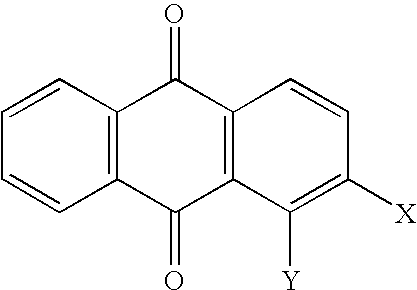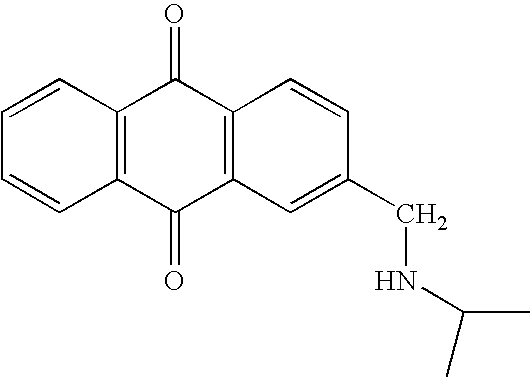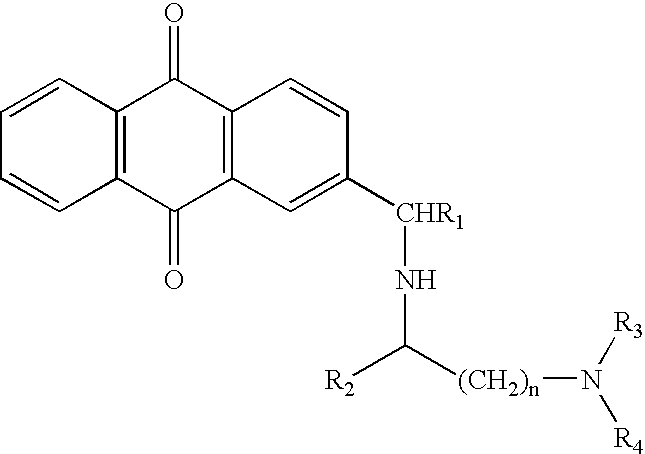Selective algaecides for control of cyanochloronta
a technology of algaecides and cyanochloronta, applied in the direction of anhydride/acid/halide active ingredients, biocides, anthracene dyes, etc., can solve the problems of negative growth conditions, limiting usefulness, and increasing ammonia concentrations
- Summary
- Abstract
- Description
- Claims
- Application Information
AI Technical Summary
Problems solved by technology
Method used
Image
Examples
example 1
Synthesis of 2-methylamino-analogs of 9,10-anthraquinone
General Procedure
[0033]2-chloromethylanthraquinone or 2-bromomethylanthraquinone was heated for 15-40 minutes at 80° C. with excess amine in the presence or absence of dimethyl sulfoxide co-solvent. The reaction mixture was cooled and mixed with ice-cold dilute hydrochloric acid and extracted with an organic solvent such as diethyl ether, ethyl acetate or methylene chloride. The aqueous layer was then basified with 20% sodium hydroxide solution and extracted with an organic solvent such as diethyl ether, ethyl acetate or methylene chloride. This extract was washed with water, dried over anhydrous sodium sulfate and evaporated. The product obtained was dissolved in methanol and precipitated as phosphate salt by treating with phosphoric acid. The precipitate was filtered off.
Specific Description
Preparation of 2-[methylamino-N-(1′-methylethyl)]-9,10-anthraquinone monophosphate (DNA2-59-1) (1)
[0034]A mixture of 2-chloromethylanthra...
example 2
[0080]
Preparation of 2-[methylamino-N-(1′-methyl-4′-N,N-diethylaminobutyl)]-9,10-anthraquinone diphosphate (DNA1-19-1) (12)
[0081]A mixture of 2-(chloromethyl)anthraquinone (20 g) and 2-amino-5-diethylaminopentane (50 ml) was stirred under nitrogen atmosphere at 80° C. for 40 minutes. The reaction mixture was poured into ice-cold HCl (5%, 500 ml) and extracted with ether (3×150 ml). The ether layer was discarded and the aqueous layer was basified with cold aqueous NaOH (10%) to pH 12 and extracted ether (3×300 ml). The ether extract was washed with water (3×300 ml) dried over anhydrous NaSO4 and evaporated to dryness under vacuum. The crystalline residue obtained was dissolved in methanol (700 ml) and mixed with phosphoric acid (85%, 25 ml in 75 ml of methanol) with efficient mixing. The mixture was allowed to stand for 1 hour, filtered, washed with methanol (4×50 ml) and dried to give 2-[methylamino-N-(1′-methyl-4′-N,N-diethylaminobutyl)]-9,10-anthraquinone diphosphate as a pale yel...
example 3
[0093]
Synthesis of 2-ethyl-1′-amino-9,10-anthraquinone analogs
General Procedure
[0094]2(1′-Bromoethyl)anthraquinone was heated for 30-60 minutes at 80° C. with excess amine in the presence or absence of dimethyl sulfoxide co-solvent. The reaction mixture was cooled mixed with ice-cold dilute hydrochloric acid and extracted with an organic solvent such as such as diethyl ether, ethyl acetate or methylene chloride. The aqueous layer was then basified with 20% sodium hydroxide solution and extracted with an organic solvent such as diethyl ether, ethyl acetate or methylene chloride. This extract was washed with water, dried over anhydrous sodium sulfate and evaporated.
[0095]The product obtained was dissolved in methanol and precipitated as phosphate salt by treating with phosphoric acid. The precipitate was filtered off.
2-[1′-Amino-N-(1′-methylethyl)ethyl]-9,10-anthraquinone 9,10-anthraquinone (DNA2-89-1) (15)
Specific Description
[0096]2[1′-Bromoethyl]anthraquinone (2 gm) was refluxed for...
PUM
| Property | Measurement | Unit |
|---|---|---|
| pH | aaaaa | aaaaa |
| diameter | aaaaa | aaaaa |
| diameter | aaaaa | aaaaa |
Abstract
Description
Claims
Application Information
 Login to View More
Login to View More - R&D
- Intellectual Property
- Life Sciences
- Materials
- Tech Scout
- Unparalleled Data Quality
- Higher Quality Content
- 60% Fewer Hallucinations
Browse by: Latest US Patents, China's latest patents, Technical Efficacy Thesaurus, Application Domain, Technology Topic, Popular Technical Reports.
© 2025 PatSnap. All rights reserved.Legal|Privacy policy|Modern Slavery Act Transparency Statement|Sitemap|About US| Contact US: help@patsnap.com



